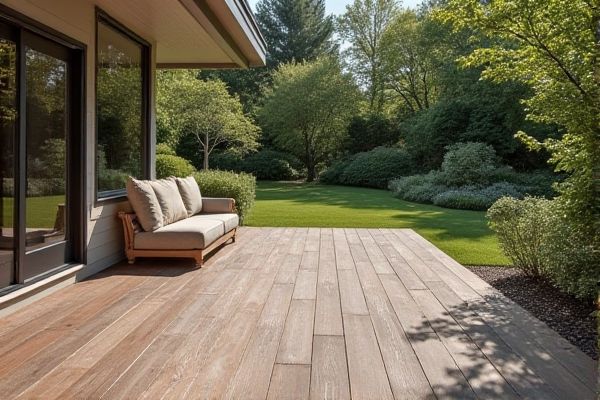
Deck tiles offer a quick, affordable, and easy-to-install solution for enhancing outdoor spaces, while composite decking provides long-lasting durability and low maintenance with a natural wood appearance. Explore this article to discover which option best suits Your outdoor renovation needs and lifestyle preferences.
Table of Comparison
| Feature | Deck Tiles | Composite Decking |
|---|---|---|
| Material | Wood, plastic, or mixed materials | Wood fibers and recycled plastics |
| Installation | Easy, snap-on or interlocking tiles, DIY-friendly | Requires professional installation or tools |
| Durability | Moderate, may fade or warp over time | High, resistant to rot, insects, and fading |
| Maintenance | Low to moderate, occasional cleaning | Low, easy cleaning, no sanding or sealing |
| Cost | Generally lower upfront cost | Higher initial investment, long-term savings |
| Appearance | Varied designs, natural wood look | Consistent finish, wood-like aesthetics |
| Portability | Highly portable, ideal for renters | Permanent installation |
| Environmental Impact | Varies by material, some renewable options | Eco-friendly, uses recycled content |
Introduction to Deck Tiles and Composite Decking
Deck tiles offer a versatile, easy-to-install solution for enhancing outdoor spaces, featuring materials like wood, stone, or composite for quick customization. Composite decking combines wood fibers and plastic to create durable, low-maintenance boards that resist rot, insects, and fading, ideal for long-term investment in your outdoor living area. Understanding the differences in installation, maintenance, and appearance helps you choose the best option to suit your deck project needs.
Material Composition: Deck Tiles vs Composite Decking
Deck tiles consist mainly of natural wood, stone, or PVC materials, offering easy installation and versatility for various surfaces. Composite decking is crafted from a blend of recycled wood fibers and plastic polymers, providing enhanced durability, low maintenance, and resistance to rot and insects. Choosing between your deck tiles and composite decking depends on the desired aesthetic, longevity, and maintenance level you prefer for your outdoor space.
Installation Process Comparison
Deck tiles offer a quick and straightforward installation process, as they can be easily snapped together or laid directly onto existing surfaces without the need for specialized tools or adhesives. Composite decking requires a more involved installation involving precise measurements, cutting, and fastening to a subframe, often necessitating professional skills to ensure proper alignment and ventilation. Your choice depends on whether you prioritize ease and speed with deck tiles or the durability and seamless finish of composite decking.
Durability and Longevity
Composite decking offers superior durability and longevity compared to deck tiles, as it resists weathering, fading, and insect damage more effectively due to its blend of wood fibers and plastic. Deck tiles, often made from natural wood or interlocking materials, may require more frequent maintenance and replacement over time because they are prone to cracking, warping, and rot. Choosing composite decking ensures your outdoor space remains sturdy and visually appealing for many years with minimal upkeep.
Maintenance Requirements
Deck tiles require minimal maintenance, as they can be easily cleaned with soap and water and replaced individually if damaged, making them ideal for quick repairs. Composite decking demands regular cleaning to prevent mold and mildew buildup, often requiring specialized cleaners to maintain its appearance and durability over time. Your choice between the two depends on whether you prefer hassle-free upkeep or a long-lasting, uniform surface that may need periodic deeper cleaning.
Aesthetic Options and Design Flexibility
Deck tiles offer a wide range of aesthetic options, including natural wood, stone, and ceramic finishes, allowing you to customize your outdoor space with unique patterns and textures. Composite decking provides consistent color and grain patterns with enhanced durability and low maintenance, ideal for long-term design stability. Your choice between deck tiles and composite decking depends on whether you prioritize quick design flexibility or lasting uniformity in appearance.
Cost Analysis: Initial and Long-Term
Deck tiles typically have a lower initial cost compared to composite decking, making them a budget-friendly option for quick outdoor upgrades. However, composite decking offers greater long-term savings due to its durability, low maintenance requirements, and resistance to rot, mold, and insect damage. Your investment in composite decking may result in fewer repairs and replacements over time, balancing the higher upfront expense with reduced ongoing costs.
Environmental Impact and Sustainability
Deck tiles made from natural wood or bamboo offer a renewable, biodegradable option with lower carbon footprints, while composite decking combines recycled plastics and wood fibers for durability but may pose recycling challenges at end-of-life. Choosing deck tiles can reduce environmental impact through easier installation and disassembly, promoting reuse and minimizing waste. Your sustainable decking decision should weigh renewable material sourcing versus long-term durability and potential recyclability.
Slip Resistance and Safety Features
Deck tiles typically offer superior slip resistance due to textured surfaces and drainage gaps that reduce water accumulation, enhancing safety in wet conditions. Composite decking, made from wood fibers and plastic, often includes built-in anti-slip additives and grooved designs to improve traction and durability. Choosing the right option depends on your need for immediate, customizable safety solutions with deck tiles or the long-term, low-maintenance safety features of composite decking.
Best Use Cases: Which Option Suits Your Needs?
Deck tiles offer versatile, easy-to-install solutions ideal for small spaces, balconies, or temporary setups where quick customization is key. Composite decking excels in durability and low maintenance, making it suitable for high-traffic areas and long-term outdoor installations exposed to varying weather conditions. Choosing between deck tiles and composite decking depends on factors like project scale, installation permanence, and desired upkeep level.
 homyna.com
homyna.com